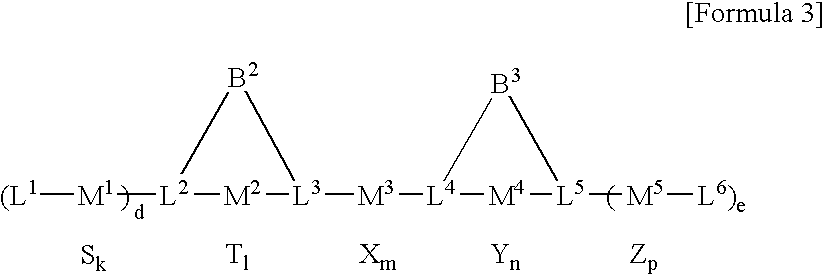Multinuclear transition metal compound and catalyst system including the same
a transition metal and catalyst technology, applied in the field of multi-nuclear metal compounds, can solve the problems of difficult control of molecular weight distribution, unsuitable processing of polyolefin, and inability to meet the requirements of processing, etc., and achieve high polymerization and stability. , the effect of high polymerization
- Summary
- Abstract
- Description
- Claims
- Application Information
AI Technical Summary
Benefits of technology
Problems solved by technology
Method used
Image
Examples
experimental example 1
Preparation of Multinuclear Transition Metal Compound (A)
[0056] After adding diethylaminotrimetylstanne (33.48 g, 141.9 mmol), indene (8.23 g, 70.86 mmol) and THF (20 ml) into a 500 mL flask under nitrogen atmosphere, and the mixture solution was refluxed by heating for 17 hours. Volatile of the obtained mixture was removed under vacuum, and as colorless liquid materials, bis(trimethylstannyl)indene of 16.42 g was obtained by distillation under reduced pressure.
[0057] Cyclopentadienylzirconium trichloride (CpZrCl3, 3.94 g, 15.0 mmol) which was slurrified by adding toluene of 70 ml was added into the mixed solution including bis(trimethylstannyl)indene (6.75 g, 15.28 mmol) and toluene of 100 ml, and then reacted for 21 hours at 85° C. Yellowish (trimethylstannyl-indenyl)(cyclopentadienyl)zirconium dichloride compound (6.71 g, yield: 86%) was obtained by a series of processes, such as removing toluene from reactant, slurrifying the obtained solid by adding hexane (100 ml) and filter...
experimental example 2
Preparation of Multinuclear Transition Metal Compound (B)
[0059] After adding litiumidenide (IndLi) powder (17.52 g, 0.144 mol) and hexane (300 ml) into a 500 mL flask under nitrogen atmosphere, tributyltin chloride (41 ml, 0.145 mol) was injected into the above mentioned flask with syringe slowly. The mixture is stirred at room temperature for 48 hours. Yellowish oil type product was obtained by a series of processes, such as separating the organic liquid by filtering reaction mixture and removing volatile from filtrate. Then the obtained yellowish oil type product was diluted with methylenedichloride (200 ml), and zirconium tetrachloride (ZrCl4, 33.03 g, 0.142 mol) was added. The mixture is stirred at room temperature for 48 hours. Indenylzirconium trichloride (IndZrCl3, 39.5 g, yield: 88%) was obtained by a series of processes, such as removing the volatile from reaction mixture, slurrifying by adding hexane (200 ml), filtering, collecting scarlet colored solid powder and drying....
experimental example 3
Preparation of Multinuclear Transition Metal Compound (C)
[0061] After adding cyclopntadiene (3.8 ml, 40.85 mmol) into diethylaminotrimethylstanne (20.7 g, 87.73 mmol), the reaction was performed at 40° C. for 3 hours. Colorless liquid, bis(trimethylstannyl)cyclopentadiene was obtained by installing the vacuum distillation system, removing volatile under vacuum, increasing the temperature of the oil bath, and doing vacuum distillation under reduced pressure. Bis(trimethylstannyl)cyclopentadiene (4.39 g, 11.21 mmol) was diluted with toluene (80 ml), then IndZrCl3 (3.5 g, 11.19 mmol) mixture was added. The reaction was performed in the oil bath at 85° C. for 21 hours (clear yellow solution). Yellowish compound, [Trimethylstannylcyclopentadienyl](Indenyl) ZrCl2] (4.18 g, yield: 74%) was obtained by a series of processes, such as removing toluene and volatile under vacuum, dissolving by adding methylene chloride (50 ml), filtering the liquid, removing volatile again, slurrifying by addi...
PUM
| Property | Measurement | Unit |
|---|---|---|
| molecular weight distribution | aaaaa | aaaaa |
| molecular weight distribution | aaaaa | aaaaa |
| molecular weight distribution | aaaaa | aaaaa |
Abstract
Description
Claims
Application Information
 Login to View More
Login to View More - R&D
- Intellectual Property
- Life Sciences
- Materials
- Tech Scout
- Unparalleled Data Quality
- Higher Quality Content
- 60% Fewer Hallucinations
Browse by: Latest US Patents, China's latest patents, Technical Efficacy Thesaurus, Application Domain, Technology Topic, Popular Technical Reports.
© 2025 PatSnap. All rights reserved.Legal|Privacy policy|Modern Slavery Act Transparency Statement|Sitemap|About US| Contact US: help@patsnap.com



